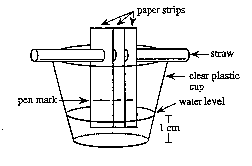Contributed by: Council of Chief State School Officers (CCSSO/SCASS)
TO THE STUDENT
Welcome to this experimental science exercise. We hope that you will
find it interesting and worthwhile. Carefully read through these directions
and the directions on the next page before you begin to work.
You may be part of a group for the first part of this exercise.
Each group should carry out the experiment and collect the data
together, but each student must record the data in his or her own
booklet. Be sure to record the data exactly as you observe them.
After the data has been collected, each student should answer the
questions independently.
After you have finished your experiment and have recorded all
of the data, you will be asked to answer some questions about the
experiment and the data you recorded. Your answers must be written
in this test booklet in the space provided. Make sure that you understand
each question before you begin to write. At any time while you are
writing your answers, you may look back to the directions for the
experiment and the data you collected. Be sure that your answers
are written as clearly and neatly as possible.
Before you turn the page, read the list of materials given below
and check to make sure that your group has everything listed.
Materials
- 12 marked chromatography strips, hole punched
- 3 unmarked chromatography strips, hole punched
- 5 250-ml containers
- 5 drinking straws
- 1 black marker
- paper towels
- straightedge
- tap water
- tape
- metric ruler
- pen or pencil
|
|
AFTER YOU HAVE READ THE DIRECTIONS, TURN TO THE NEXT PAGE AND BEGIN.
Paper Chromatography
Paper chromatography is a technique that can be used to separate
certain chemicals from each other. In this event, you will use paper
chromatography to separate the inks which have been placed on several
strips of chromatography paper. You will also use paper chromatography
to identify the ink in a marking pen.
- Find the fifteen paper strips in your materials (three each
labeled A, B, C, D, and three unlabeled). When handling the strips,
pick up the strips by a corner nearest the punched hole. Strips
A, B, C, and D are already marked with a black pen line. Use the
black pen provided and a straightedge to draw black lines on the
unmarked strips at the ends furthest from the punched hole. Draw
straight lines 2 cm from the end of each unmarked strip.
- Add tap water to a depth of 1 cm in each of the five plastic
cups.
- Each member of the group should take three strips (for example,
A, A, A) and place a drinking straw through the punched holes
in the tips of the strips. Suspend the strips in the cup so the
tips are under water. Do not allow the black pen lines on the
strips to be under water. Do not allow the strips to contact each
other. See the diagram below.

- Allow the experiment to run until the water approaches the bottom
of the punched holes. Remove the strips from the cups. Take the
strips off the straws and lay the strips out on a paper towel.
- Cut each strip in two lengthwise so that each member of the
group has one of each. Make sure that each piece is correctly
labeled. The pieces of the strips originally unmarked should now
be marked E. Tape the strips in your test booklet. If there are
extra strips, discard them.
When your strips are dry, tape each of the strips in the space
below.
| Strip A |
Strip B |
Strip C |
Strip D |
Strip E |
Questions
Please answer the following questions by yourself.
- Were the black pen lines on Strips A, B, C, D, and E made by
the same pens? Using your results, explain why you think the lines
were or were not made by the same pens.
___________________________________________________________________
___________________________________________________________________
___________________________________________________________________
___________________________________________________________________
- Suppose that one paper strip was marked with two of the links
used in this experiment, and the two ink lines on the strip were
drawn on top of each other. Design and discuss an experiment that
could be used to identify these two inks.
___________________________________________________________________
___________________________________________________________________
___________________________________________________________________
___________________________________________________________________
___________________________________________________________________
___________________________________________________________________
___________________________________________________________________
___________________________________________________________________
|


